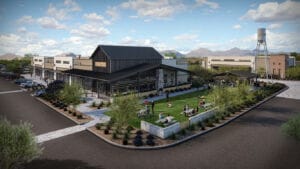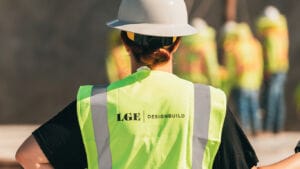Andy Abraham, president of Burch & Cracchiolo, has handled plenty of real estate transactions in his near-40-year career. But his work on the recent sale of 12,081 acres of land in the far West Valley for $142.54 million stands out as being particularly complex. Abraham represented the group purchasing the property, Levine Investments Limited Partnership, Andrew Cohn and Gary Tharaldson, who together formed BA Pacific Sun Valley LLC. The seller was WVSV Holdings, an entity affiliated with Conley Wolfswinkel of W Holdings based in Tempe.

“Buying 12,000 acres is never like falling off a turnip truck, so to speak,” Abraham says. “But this [transaction] is a whole lot different than if you owned 12,000 acres and said to me, ‘I’ll sell it to you for $134 million’ — that’s relatively easy. If I rated a standard vanilla transaction having a one or two for risk factors, this one is a 10 plus. This is at the extreme of a transaction with lots of hair on it.”
The reasons why this deal is convoluted are myriad and trace back decades.
The Road to Nowhere
Outlining the northern and western edges of the White Tank Mountain Regional Park is a strip of pavement called Sun Valley Parkway. Before the far West Valley began its current growth spurt, the parkway had another name — “The Road to Nowhere.”
That moniker came about after an attempt by developer William Robert Burns to construct a project purported to house 300,000 people fizzled. According to court records, Burns proposed a deal to acquire land in the far West Valley to a group of investors, and by June 1995, those investors had formed 10K LLC for the purpose of acquiring, developing and selling the land.
Another entity, known as Phoenix Holdings II and controlled by Burns and Brent Hickey, was hired to manage 10K LLC’s affairs. An additional 3,200 acres was added to the original parcel through an agreement with Glen Spurlock, before Breycliffe LLC was identified as a buyer by Burns.
READ ALSO: How the West Valley is building the workforce needed to fuel growth
Breycliffe LLC was supposed to satisfy a set of conditions per the transaction agreement which never were settled. Litigation ensued, and Phoenix Holdings II “on behalf of Breycliffe, had been secretly marketing that interest to third parties, while at the same time soliciting substantial profit participation for Phoenix Holdings in any such agreement,” according to Cal X–Tra v. WVSV Holdings.
The 10K investors discovered this and protested. Furthermore, they learned that Burns and Phoenix Holdings were going to offer Breycliffe’s acquisition interest to Conley Wolfswinkel, “a businessman and real estate investor who had federal convictions for bank fraud, conspiracy to commit bank fraud and misapplication of bank funds, and aiding and abetting misapplication of bank funds” and “two civil judgments in excess of one billion dollars each entered against him related to fraudulent business activities” as described in Cal X–Tra v. WVSV Holdings. The deal ended up proceeding, and years of lawsuits followed.
Wolfswinkel did not respond to a request for comment.

West Valley land
What was once farm land in the far West Valley now is a rapidly expanding part of Metro Phoenix. The western edge of the Loop 303 has attracted manufacturing and logistics companies from mattress brand MLILY to Amazon.
“The [original] seller of the land was a family of farmers, and the buyer of the land was an entity that was a Conley Wolfswinkel-related entity called WVSV Holdings,” he says.
WVSV Holdings ended up embroiled in litigation with Leo Beus, co-founder of the law firm Beus Gilbert McGroder PLLC, which concluded with a judgment being awarded. According to a final settlement statement dated March 25, 2022, the judgment balance was $92.06 million, and shows WVSV also owed $45.41 million to 2M & H, LLC.
“If you look at the bankruptcy filing, you’ll see that [WVSV Holdings] owed [approximately] $40 million back to the original sellers on the purchase, and they owed about $90 million on this judgment,” Abraham explains. “Essentially, [Wolfswinkel] had a lien against his property. To protect the property from being lost to the judgment, WVSV filed bankruptcy, and there was a process in the bankruptcy court that ultimately allowed WVSV to sell.”
That is when the group Abraham represented surfaced as potential buyers. “They saw the value in this property,” he says. “When WVSV said they would sell the property, they had to get bankruptcy court approval to sell it. And we made a proposal that WVSV liked which paid off the judgment, the amount due under the purchase, covered a few other expenses and essentially bought the property out from WVSV through the First American trust.”
Moreover, “The Road to Nowhere” is going to see much more traffic as the Douglas Ranch master-planned community comes to fruition in the coming years on the west side of the White Tank Mountain Regional Park. An estimated 300,000 residents will eventually live in 100,000 homes with 55 million square feet of commercial development nearby.
Abraham notes that no plans are finalized for the property, but there’s likely to be residential and commercial components to come.
“Imagine the beauty of having 12,000 acres that’s not encumbered with a whole bunch of land use history,” he concludes. “It’s a clean palette to put a location-appropriate project on and be creative, and that’s what the buyer plans to do with it.”



